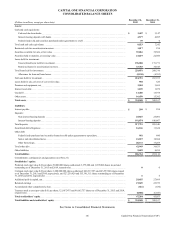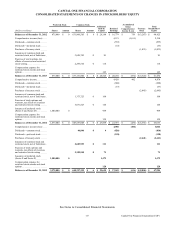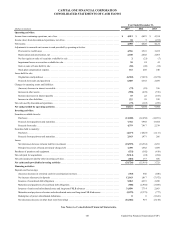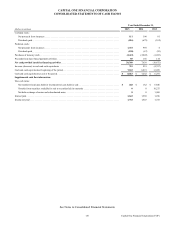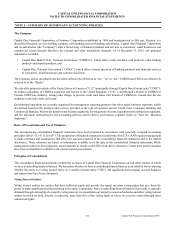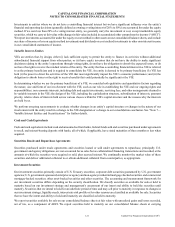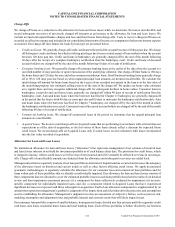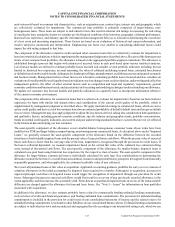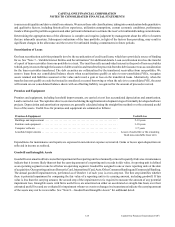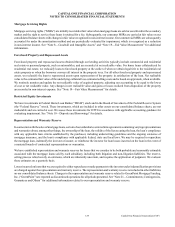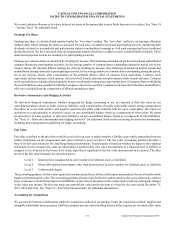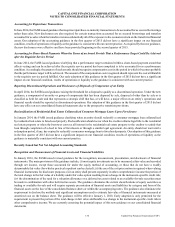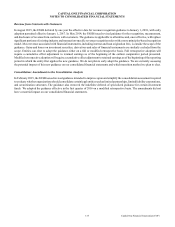Capital One 2015 Annual Report Download - page 144
Download and view the complete annual report
Please find page 144 of the 2015 Capital One annual report below. You can navigate through the pages in the report by either clicking on the pages listed below, or by using the keyword search tool below to find specific information within the annual report.CAPITAL ONE FINANCIAL CORPORATION
NOTES TO CONSOLIDATED FINANCIAL STATEMENTS
125 Capital One Financial Corporation (COF)
credit card loans issued in the U.K. as nonperforming when the account becomes either 90 or 120 days past due depending
on the specific facts and circumstances.
• Consumer banking loans: We classify consumer banking loans as nonperforming when we determine that the collectability
of all interest and principal on the loan is not reasonably assured, generally when the loan becomes 90 days past due. We
accrue interest on consumer installment loans until charge off.
• Commercial banking loans: We classify commercial banking loans as nonperforming as of the date we determine that
the collectability of all interest and principal on the loan is not reasonably assured.
• Modified loans and troubled debt restructurings: Modified loans, including TDRs, that are current at the time of the
restructuring remain on accrual status if there is demonstrated performance prior to the restructuring and continued
performance under the modified terms is expected. Otherwise, the modified loan is classified as nonperforming and placed
on nonaccrual status until the borrower demonstrates a sustained period of performance over several payment cycles,
generally six months of consecutive payments, under the modified terms of the loan.
• Acquired Loans: Acquired Loans are not classified as delinquent or nonperforming.
Interest and fees accrued but not collected at the date a loan is placed on nonaccrual status are reversed against interest and fee
income. In addition, the amortization of net deferred loan fees is suspended. Interest and fee income is subsequently recognized
only upon the receipt of cash payments. If there is doubt regarding the ultimate collectability of loan principal, all cash received
is generally applied against the principal balance of the loan. Nonaccrual loans are generally returned to accrual status when all
principal and interest is current and repayment of the remaining contractual principal and interest is reasonably assured, or when
the loan is both well-secured and in the process of collection and collectability is no longer doubtful.
Impaired Loans
A loan is considered impaired when, based on current information and events, it is probable that we will be unable to collect all
amounts due from the borrower in accordance with the original contractual terms of the loan. Generally, we report loans as impaired
based on the method for measuring impairment in accordance with applicable accounting guidance. Loans held for sale are not
reported as impaired, as these loans are recorded at lower of cost or fair value. Impaired loans also exclude Acquired Loans
accounted for based on expected cash flows at acquisition because this accounting methodology takes into consideration expected
future credit losses.
Loans defined as individually impaired, based on applicable accounting guidance, include larger balance nonperforming loans and
TDR loans. Our policies for identifying loans as individually impaired, by loan category, are as follows:
• Credit card loans: Credit card loans that have been modified in a troubled debt restructuring are identified and accounted
for as individually impaired.
• Consumer banking loans: Consumer loans that have been modified in a troubled debt restructuring are identified and
accounted for as individually impaired.
• Commercial banking loans: Commercial loans classified as nonperforming and commercial loans that have been modified
in a troubled debt restructuring are reported as individually impaired.
• Acquired Loans: Acquired Loans are tracked and reported separately from other impaired loans.
The majority of individually impaired loans are evaluated for an asset-specific allowance. Although a loan modified in a TDR may
be returned to accrual status if the criteria described above under “Delinquent and Nonperforming Loans” are met, we continue
to report the loan as impaired until maturity.
We generally measure impairment and the related asset-specific allowance for individually impaired loans based on the difference
between the recorded investment of the loan and the present value of the expected future cash flows, discounted at the original
effective interest rate of the loan at the time of modification. If the loan is collateral dependent, we measure impairment based
upon the fair value of the underlying collateral, which we determine based on the current fair value of the collateral less estimated
selling costs, instead of discounted cash flows. Loans are identified as collateral dependent if we believe that collateral is the sole
source of repayment.



